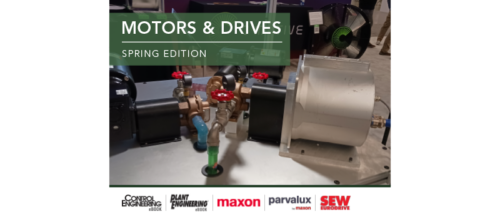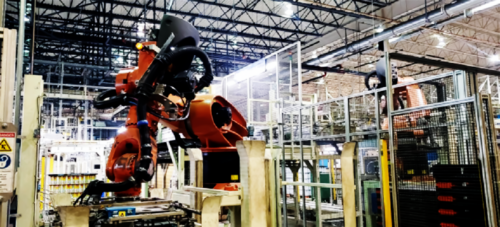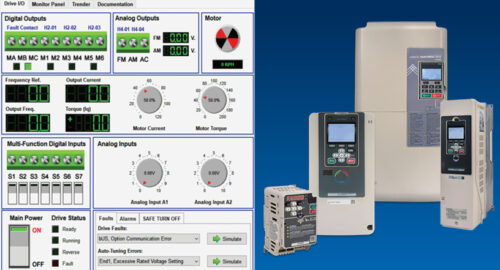Energy Management: First Steps Toward Greater Efficiency
This article series provides specific examples of how engineers can identify and address - at relatively little or no cost - principal sources of energy waste in their production facilities. Part one focuses on facility and machine power use and motors and drives. Part two will focus on energy reuse and application-specific energy savings.
|
As an engineer, you’re faced with countless areas to target with the goal of gaining greater efficiencies. Despite the recent plunge in some energy prices, there’s still really no better place to focus your efforts than on your facility’s energy use. Those prices won’t stay low for long, which means the steps you take now to cut energy costs will actually increase in value to the business as time goes on.
This article series is designed to highlight the more straightforward and easily remedied energy concerns in both discrete and process manufacturing plants. Basic advice on how to identify and address these issues is provided for each area covered.
Facility and machine power usage
An important first step for engineers interested in managing their facility’s energy usage is to understand how much energy they are consuming and how they are using the energy, says Corey Morton, product manager with B&R. “This can easily be done by working with local utilities, using portable measurement devices, or installing energy measurement devices,” he says.
| Because the industrial sector accounts for the largest portion of energy consumption in the U.S., the inherent potential for significant savings is also greater. |
Morton says one of the easiest ways to address energy usage is for engineers to observe the way their plant operates to enact an energy management discipline known as “load shedding.” “For example, consider a plant that runs two production shifts,” he says. “Many of their operations may be pneumatic, and are supplied from a central air compressor. Because there are only two shifts, there is no need to run the compressor during the third shift. This same train of thought can easily be expanded to HVAC systems, plant lighting, and water systems.”
Another easy way to address energy consumption is to observe “running demands.” If a plant also uses a great deal of water as part of the production process, the amount of water used will vary based on the number of machines being run at any one time. “If the motors driving the pumps are operated across the line (i.e., they are turned on/off with contactors at line voltage), the same amount of power is being consumed independent of the actual demand,” Morton notes. This issue can be addressed by measuring demand (flow) and varying the pump speed with a drive based on demand.
An additional benefit to addressing running demands can be an improvement in “power factor,” as a drive/motor system will typically have a higher power factor than the motor alone. In general terms, power factor is a measure of how well the plant is using its power. “A lower power factor means the utilities’ and plants’ distribution system must be sized to supply the power being used to produce work (real power), as well as the apparent power,” Morton says. “As a result, utilities may pass along a surcharge to plants with a low power factor.”
The pump application mentioned above can also serve as an example of “peak demand.” Each time the pump is started, depending on the motor size, it can result in a large inrush of current. This, in turn, will result in a momentary increase in the plant’s power consumption. Many plants contract rates with their utility based on typical demand. Any peak in demand may be enough to push the plant into a higher rate bracket for the entire billing cycle. “An easy method for limiting this inrush current is through the use of a soft starter or drive, which ramps the motor to running speed,” says Morton, “thereby reducing the starting current.”
Even applications that already use drives may provide opportunities for energy management. For example, an application may have motor-driven sections that unwind material, process the material, and then rewind the finished material. “In these cases, the unwind typically runs in a regenerative mode, meaning power is being pushed from the motor back to the drive,” Morton says. “The drive must then do something with this energy; in many cases it just discharges the energy with resistors—often referred to as a braking resistor. Therefore, the regenerated energy is wasted. One way of utilizing this energy would be to share the dc bus of each drive (see dc bus sidebar for more information). This allows the drives consuming power to utilize the regenerative power of the unwind drive.”
Morton notes that although sharing the dc bus of each drive can reduce the amount of wasted energy, it may not completely eliminate the waste. “A braking resistor may still be required to dissipate the excess energy,” he adds.
Motors and drives
Considering that motor systems are one of the top three sources of industrial energy consumption (see “U.S. Industrial Energy Consumption” graphic), it makes sense for automation engineers to focus a considerable amount of attention on this area.
“Surprisingly, only 30% of the manufacturing industries use variable frequency drives (VFDs) with their three-phase motors,” says Ron Koehler, director of next generation products at Yaskawa Electric. However, applying VFDs to three-phase motors is one area where engineers can directly affect the company’s bottom line.
Koehler suggests engineers consider the following four drives-related issues to save both energy and money over time by using drives. “The best thing about most of these suggestions is that they don’t cost anything to implement,” says Koehler, “so the benefits can only be positive in return.”
-
Stop oversizing drives and motors. Check the load requirements needed for a particular project to maximize the potential of the drive. If you reduce the speed and torque of a drive, it will obviously reduce the energy consumed to accomplish the job. Engineers should be able to look at the application being performed and determine what size drive is needed to accomplish the job.
-
Finless drives. These specially designed drives can be beneficial, as they can reduce the need for additional cooling methods. This is possible as a special heatsink feature allows for the release of heat out the back of the drive. Overall, this reduces the size of the cabinet needed and limits the amount of cooling needed for the drive.
-
Sequencing of operation by use of on/off heatsink fan control. The use of an automatic on/off fan control will reduce the use of unnecessary power, as you will be saving energy and money when it’s not being used. This may sound like a simple idea, but many times it is not enforced and energy is lost. Engineers should make sure that a drive has this option and that it is being used.
-
Permanent magnet control. Motors with permanent magnet (PM) control utilize the magnetic field to the motor’s advantage. These motors are capable of increasing energy savings even higher than the NEMA standards, says Koehler. “Sometimes they can be a couple of percent better than a high-efficiency motor,” he adds.
To access Part Two of this article (originally published in February 2009), click here .
| Author Information |
| David Greenfield is editorial director of Control Engineering. He can be reached at david.greenfield@reedbusiness.com |
How variable frequency drives reduce energy costs
Numerous vendors tout the energy savings potential of variable frequency drives (VFDs). So just how do they reduce energy costs? “By eliminating high in-rush currents when motors are started,” says Rich Mintz, U.S. product manager for SEW Eurodrive. “Utilities charge customers for peak demand. By limiting the starter peak and keeping peak demand as low as possible, VFDs can yield considerable savings, especially on high cyclic applications.”
Mintz explains that the basic principle of an induction motor is that the voltage is applied to the motor windings, causing a rotating electromagnetic field in the windings. At the same time, this induces a magnetic field in the rotor.
“These two fields are not in sync,” Mintz says. “The rotor moves to try to catch the rotating field in the stator. The difference in speed in the rotating field in the stator and the rotational speed of the rotor is called slip. The force at work to minimize this slip is torque. The greater the slip, the more current the motor will draw in order to reduce the slip.”
Starting an induction motor across the line causes the motor to draw high starting current (up to 10 times nominal or full-load current) to get the motor turning. When the motor is started across the line, the slip is 100% because the motor is trying to “catch the rotating electromagnetic field that is suddenly generated in the windings,” says Mintz.
“In order to catch up, the motor will draw as much current as it can. When the motor reaches its nominal speed, the slip is minimized, so the current will drop down to its running or nominal current to maintain speed,” Mintz explains.
By applying a VFD, the voltage and frequency are applied and adjusted in a selectable or adjustable linear ramp. “Therefore, the motor speed is never far from the rotational speed of the electromagnetic field—meaning the slip is always minimized—so it never produces the high current to make up the difference,” says Mintz.
Large industrial or power generation companies will find it necessary to explore the larger end of the VFD spectrum. For such operations, large medium voltage (MV) VFDs can be one of the better options for achieving energy savings and improved electrical system performance.
“Over the past 20 years, large industrial and power generation companies have begun employing this technology and the results are well proven,” says Mark Harshman, director, Nuclear Drives Business, Siemens Energy & Automation.
Harshman explains that energy savings with MV VFDs are achieved via mechanical and electrical benefits.
“Together, the mechanical and electrical benefits provide significant market value add savings,” he says. “For example, power plants can achieve 1.0-1.5% heat rate improvement. Energy typically used in throttle control for pump applications and damper control for fan applications is now available to be put back into the power supply grid and customer use. Furthermore, the high availability feature of large MV VFDs can include multiple switching devices and a process-forgiving control program.”
Large VFDs are considered by many engineers to be easy to install/retrofit into a process, says Harshman. “They can be located anywhere in the facility and easily retrofitted on any existing motor,” he says.
Reusing energy via a common dc bus
Applications where at least two variable frequency drives are combined on a coordinated system can take advantage of having several inverters being connected to a common dc bus, according to Ron Koehler, director of Next Generation Products for Yaskawa Electric. Connecting VFDs via a common dc bus allows for power load sharing on the dc bus, because different inverters simultaneously drive the motor and generate power.
“Here’s how it works,” says Koehler: “The regenerative energy produced during deceleration can be reused and recycled right back to the line for best system energy efficiency, rather than wasting it by getting rid of it. Engineers can reconfigure their systems to make sure that this energy is being utilized wisely so that less power from the rectifier is needed or used, making the system more efficient.”
Because dc bus terminals are standard on most VFDs, the material cost is minimal; however, Koehler adds, “engineer involvement is necessary.”
| Common bus connections provide the ability to transfer energy form a regenerating load back to the main input line. |
Do you have experience and expertise with the topics mentioned in this content? You should consider contributing to our CFE Media editorial team and getting the recognition you and your company deserve. Click here to start this process.





